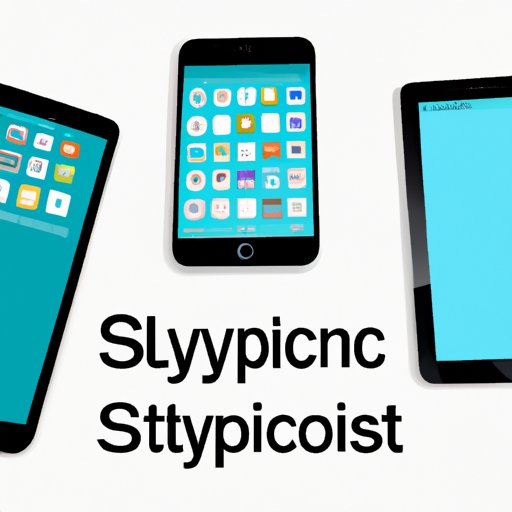Introduction
Synchronizing your iPhone and iPad is a great way to ensure that you have access to all your data, media, and settings across multiple devices. Whether you’re switching between devices or want to keep your data up-to-date on both devices, syncing can be a lifesaver. In this article, we’ll take you through a step-by-step guide on how to sync iPhone and iPad using various methods, including iCloud, iTunes, cable, and third-party apps.
Step-by-Step Guide for Syncing iPhone and iPad
To start syncing your iPhone and iPad, you need to follow these basic steps:
- Ensure that both devices are running the latest version of iOS.
- Connect both devices to the same Wi-Fi network to enable wireless syncing.
- Select the data types, media files, and settings that you want to sync.
- Choose a syncing method that suits your needs.
Syncing iPhone and iPad via iCloud
iCloud is Apple’s cloud-based platform that enables you to store, share, and access your data across multiple devices. Using iCloud, you can sync your contacts, calendars, photos, music, and other data wirelessly. Here are the steps for setting up iCloud:
- Open the Settings app on your iPhone or iPad.
- Tap on your Apple ID at the top of the page.
- Tap on iCloud and enable the options for the data types that you want to sync.
- If prompted, sign in to iCloud using your Apple ID.
- Repeat the same steps on your other device to enable iCloud syncing.
Once you’ve set up iCloud syncing, your data will stay up-to-date across both devices automatically. However, be sure to keep an eye on your iCloud storage limit, as overuse can lead to additional charges.
Syncing iPhone and iPad Using iTunes
iTunes is Apple’s media management software that lets you organize, sync, and play media files such as music, movies, TV shows, and more. Using iTunes, you can also sync files from your computer to your iPhone and iPad. Here’s how to use iTunes to sync your media files:
- Open iTunes on your computer and connect your iPhone or iPad using a USB or lightning cable.
- Select your device icon from the top-left corner of the iTunes window.
- Click on the type of media that you want to sync (e.g., Music, TV Shows, Photos, etc.).
- Select the files that you want to sync and click on the Apply or Sync button.
- Disconnect your iPhone or iPad once the sync is complete.
Note that iTunes syncing requires a physical connection between your devices and a computer running iTunes. Also, be mindful of your storage capacity, as large media files can quickly eat up your device’s storage.
Third-Party Apps for Syncing iPhone and iPad
Third-party apps can offer additional functionality for syncing your iPhone and iPad across multiple devices. Here are some popular apps to consider:
- Google Drive: Syncs photos, documents, and other files across devices.
- Dropbox: Syncs files and folders across devices, including automatic photo backup.
- OneDrive: Syncs files, folders, and photos across devices, with 5 GB of free storage.
- AnyTrans: Syncs photos, music, and other data types between iPhone and iPad, with built-in backup and restore features.
Before choosing a third-party app, be sure to check its compatibility with your devices and the type of data you want to sync. Also, consider the pricing and features for each app carefully.
Syncing iPhone and iPad with a Cable
If you prefer a physical connection between your devices, syncing via cable is a good option. Here’s how to do it:
- Connect your iPhone or iPad to your computer using a USB or lightning cable.
- Open iTunes and select your device icon.
- Click on Sync or Apply to sync the selected data types.
- Disconnect your devices once the sync is complete.
Syncing via cable allows for faster transfer speeds and more reliable syncing. However, keep in mind that it requires a physical connection and may not be as convenient as wireless syncing.
Troubleshooting Tips for Syncing iPhone and iPad
Even with the best of intentions, syncing issues can still occur. Here are some common issues and solutions you can try:
- Check your Wi-Fi or cable connection and ensure that both devices are connected to the same network.
- Restart both devices and try syncing again.
- Reset your settings on both devices and try the syncing process again.
- Ensure that you have enough storage space on both devices and iCloud.
- Update your iOS and iTunes to the latest version to avoid compatibility issues.
If the problem persists, Apple Support or the app developer may be able to offer further assistance.
Conclusion
Syncing your iPhone and iPad can be a convenient way to keep your data up-to-date and accessible across multiple devices. By following our comprehensive guide, you can sync your iPhone and iPad easily via iCloud, iTunes, cable, or third-party apps. Remember to keep an eye on your storage, compatibility, and troubleshooting tips, to avoid any hiccup while syncing.
